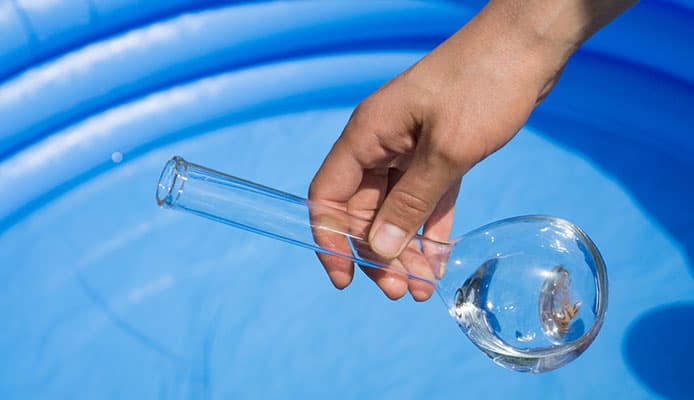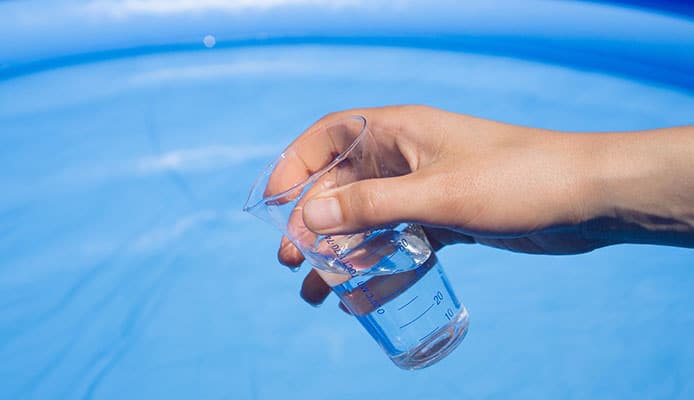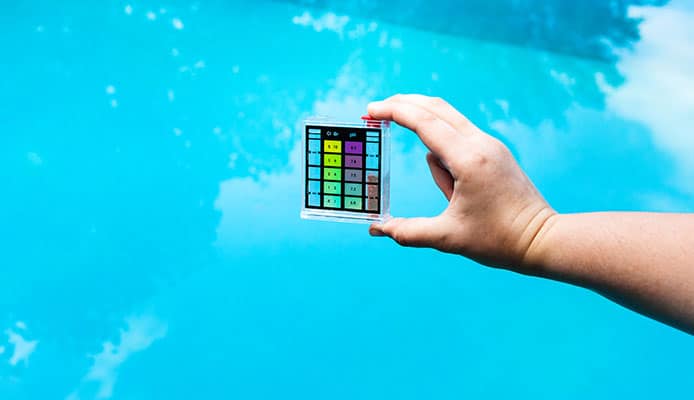
-
1.
-
2.
-
3.
-
4.
Keeping your pool clean and safe to use is very important. One of the basic things is eliminating bacteria and algae by adding chlorine. Unfortunately, the chlorine present in the water will become ineffective over time, and won’t be able to do what it’s supposed to.
For this reason, shocking your pool every once in a while is highly recommended. This process significantly raises the chlorine levels and quickly sanitizes the pool. As you maybe know, several different types of pool shocks are available, with differences in terms of strength and the way they are used.
Our goal is to help you find the best pool shock so that you can take your next dip in clean and crystal clear water. Make sure to check out the products we picked out for you, and also the buying guide below where we break down the different features and give pointers on how to make the right choice.
OUR TOP PICK
Leisure Time RENU2 Renew Non-Chlorine
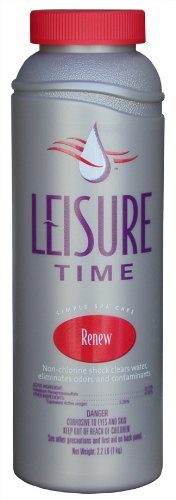
- Stand Out Features - Why We Love It
- Non-chlorine formula allows swimming in fifteen minutes
- Works with any purification system (chlorine, bromine, ozone, mineral)
- Cleans and eliminates microorganisms, oils, and soaps
Active ingredient: 32.2% Potassium peroxymonosulfate (non-chlorine oxidizer)
Use: 4oz per 250 gallons
Swim-ready: 15 minutes
Product weight: 2.2 pounds
EDITORS CHOICE
hth Super Shock Treatment 4-in-1
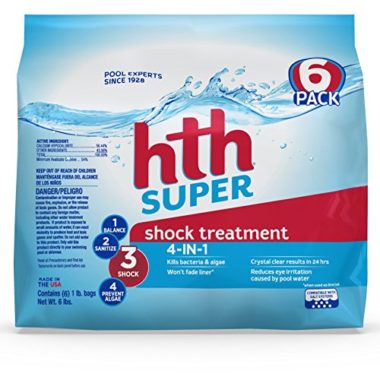
- Stand Out Features - Why We Love It
- Dissolves easily and acts quickly
- Effective against both bacteria and algae
- Suitable for fresh and saltwater systems
Active ingredient: 56% calcium hypochlorite
Use: 1 pound per 13,500 gallons
Swim-ready: 24 hours
Product weight: 6 x 1 pound
BEST VALUE
DryTec High Quality Calcium Hypochlorite Cal Hypo
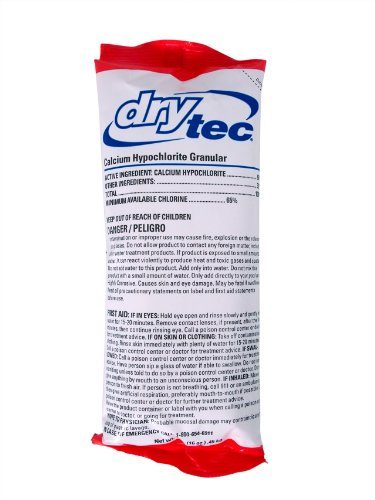
- Stand Out Features - Why We Love It
- Very efficient against bacteria and organic contaminants
- Strong against algae (in higher concentrations)
- Quick-dissolving granules for faster results
Active ingredient: 68% calcium hypochlorite
Use: 1 pound per 10,000 gallons
Swim-ready: when chlorine drops to 1-4ppm
Product weight: 1 pound
Clorox Pool&Spa XtraBlue Chlorinating Granules
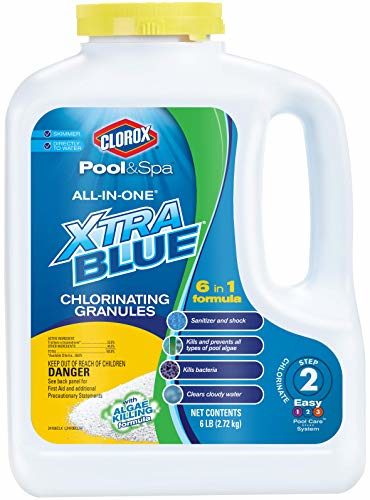
- Stand Out Features - Why We Love It
- Lower chlorine odor and eye irritation
- Great for shocking or regular maintenance
- Compatible with any type of pool
Active ingredient: 53.5% Trichlor
Use: 1 pound per 10,000 gallons (to shock)
Swim-ready: 24 hours
Product weight: 6 pounds
Pool Essentials Treatment
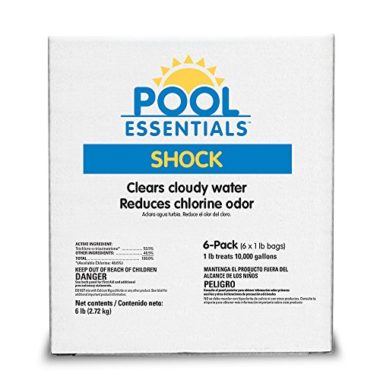
- Stand Out Features - Why We Love It
- Easily resolves cloudy water
- Safe for adding directly to the swimming pool
- Budget-friendly option
Active ingredient: 53.5% Trichlor
Use: 1 pound per 10,000 gallons
Swim-ready: when chlorine goes under 4ppm
Product weight: 6 x 1 pound
Clorox Pool&Spa 33506CLX XtraBlue
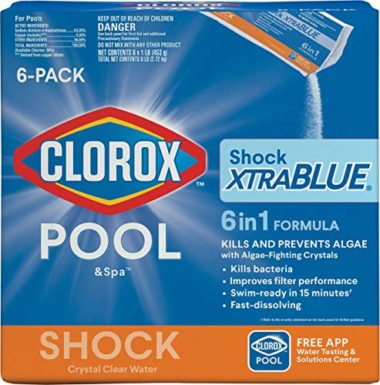
- Stand Out Features - Why We Love It
- Algae-fighting crystals prevent any type of algae
- Formula improves filter efficiency and water circulation
- Doesn’t bleach the liner or affect pH level
Active ingredient: 63% Sodium Dichlor
Swim-ready: 15 minutes
Product weight: 6 x 1 pound
Aqua Chem Xtra Blue
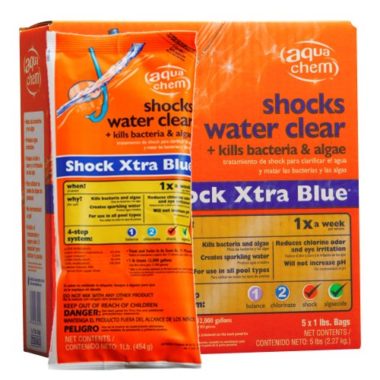
- Stand Out Features - Why We Love It
- Pool can be used again in just 15 minutes
- Contains copper to fight algae better
- No chlorine odor or pH increase
Active ingredient: 63% Sodium Dichlor
Use: 1 pound per 12,000 gallons
Swim-ready: 15 minutes
Product weight: 5 x 1 pound
Clorox Pool&Spa Chlorine-Free Saltwater
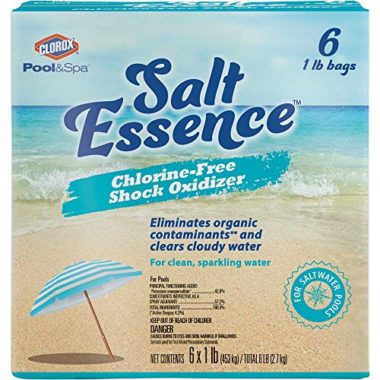
- Stand Out Features - Why We Love It
- Chlorine-free formula is safer to use
- Efficient at clearing a cloudy pool
- Top-level performance in saltwater swimming pools
Active ingredient: 42.8% Potassium monosulfate (non-chlorine oxidizer)
Use: 1 pound per 10,000 gallons
Swim-ready: 15 minutes
Product weight: 6 x 1 pound
How To Choose A Pool Shock – Buying Guide
As you had the chance to see, different types of pool shock exist. Getting the right one for your pool depends on a few things, for example, how much water you need treated, what type of pool you have, and what kind of results you expect.
Pool Type
Pool shocks contain very aggressive substances, but they usually won’t cause any damage to your pool. This being said, there are situations when you need to be more careful.
For example, if your pool is lined with vinyl, it would be smart to avoid chlorine-based pool shocks. The reason behind this is that undissolved chlorine can bleach the vinyl liner, create tiny pinholes, or make it more rigid. In this case, it’s best to use some of the non-chlorine options available.
If you have a fiberglass pool, you have nothing to worry about. They are very tough, and the gel surface layer is completely resistant to all chemicals used in a swimming pool.
The third option is a concrete pool. They have a concrete shell, with a layer of plaster inside the pool. Depending on the type of plaster used, undissolved shock can cause very small pitting on the surface, but that isn’t really a problem. Also, your pool paint won’t be affected either.
Finally, no matter what type oThe capacity of your pool dictates hf water you have in your pool, you still need to shock it. In our reviews, we featured many products that can successfully be used in both.
Pool Size
ow much shock you will need to successfully treat it. Most products work with about 1lb of shock for every 10,000 gallons in your pool. However, some products are stronger and able to treat a larger amount of water with a 1lb dose.
You should check on the product label, and calculate how much you need for shocking the pool throughout the season. It’s more affordable if you buy shock in bulk instead of ordering several times. On the other hand, don’t buy too much either. It becomes less potent as time goes, so it’s usually better to buy a new batch next year.
Type Of Pool Shock (Active Ingredients)
Your pool shock will usually rely on one of these three active ingredients to sanitize your pool – calcium hypochlorite, sodium di-chlor, and potassium peroxymonosulfate. Even though they all serve the same purpose, there are some differences between them.
Calcium hypochlorite
Calcium hypochlorite is a very popular and common choice for shocking a pool. It’s probably the best shock for pool if you’re looking for strength, as it usually comes with 65 to 75% of active chlorine. You should add it during the evening and let it work overnight. The reason for this is that calcium hypochlorite is sensitive to the sun, which burns the chlorine off.
You can usually swim again in the morning, but be sure to check the pool chemistry and see whether the chlorine level has returned to normal. If your pool already has a lot of calcium in it, an alternative shock (similar to this one) is lithium hypochlorite, but it’s a bit more expensive too.
Sodium DiChlor
It also has chlorine as an active ingredient, but dissolves slower than the previous one. In addition, it contains a stabilizer (cyanuric acid) which is a plus because it stabilizes the chlorine level and protects it.
It’s a good choice for regular pool maintenance. An additional plus is that it can often be added directly to the pool, instead of dissolving it in a bucket.
You might also like: Best Pool Test Strips
Potassium peroxymonosulfate
If you’re looking for a shock treatment without any chlorine, you should get one that contains potassium peroxymonosulfate. It works by oxidizing the water and killing off bacteria and other contaminants. A big advantage is that this one isn’t affected by the sun, so it’s the best pool shock to add during any time of day.
In addition, it works fast so you can continue swimming very quickly (usually within an hour). It has one downside though – it doesn’t kill off algae (because it contains no chlorine). This means you would need to buy an algaecide separately, and combine it with the shock to get the best possible protection for your pool.
FAQs
Q: What Does A Pool Shock Do?
A pool shock sanitizes your pool by eliminating bacteria, algae, and neutralizing organic agents. Chlorine-based pool shocks work by raising the chlorine level very high, while non-chlorine swimming pool shocks work as oxidizing agents. Pool shocks make your pool safe to use (no risk of infection or irritation), and also make your water clear.
One of many useful swimming pool tips is to shock your pool regularly if you want it to be odorless. Shocking eliminates organic compounds in chloramines which cause the unpleasant pool smell and reactivates the chlorine.
Q: Should I Buy Liquid Or Powdered Shock?
Q: When’s The Best Time to Shock My Pool?
This depends on the type of shock you use. Like we discussed, a chlorine-based shock for swimming pools shouldn’t be used during the day. This is because the sunlight causes chlorine to evaporate and reduces its level, which beats the purpose of superchlorinating in the first place.
If you’re using this type, it’s recommended that you do it in the evening and let it work overnight to get the best results. The non-chlorine type can be used at any time of the day since sunlight doesn’t affect it.
Q: How Do I Shock My Pool?
The first and most important thing to do is read the instructions if you want it to work optimally. Some shocks need to be dissolved, while others are directly poured into the water (preferably the deep end of your pool). Also, some shocks can be poured into the skimmer.
Before you enter the pool again, always measure the chlorine level. Usually, you’ll need to wait about 24 hours until it’s safe to swim after shocking the pool. The level must drop below 4 ppm, and only then is your pool safe to use.
Q: How Often Can You Shock A Pool?
In regular circumstances, you should shock your pool once a week. However, some situations require that you do it more often. These scenarios include a large number of pool users, very warm weather, large amounts of rain or very persistent algae.
You should buy a reliable pool test kit and regularly test your pool water. When you notice that the chlorine levels are too low, it’s time for a shock treatment. Also, be sure to learn how to fix a green pool after rain, to make things faster.
Q: Can You Shock A Pool Without The Pump Running?
Yes, but this isn’t ideal. There is a possibility that the chlorine will gather in one spot, which will be ineffective and even damage the liner (if it’s made of vinyl). It’s best to leave the pool pump on while the shock is working, so the water can circulate and make the whole process faster and more efficient.
Q: Can You Shock A Pool Too Much?
Technically no, but it can cause problems. Adding too much shock will kill algae and bacteria faster, but you’ll have to wait a long time to get in the water.
Entering a pool with too high chlorine levels can be dangerous for your health. If you slipped and added too much, you can leave it to burn out in the sunlight or add a chlorine neutralizer to drop the level.
Q: Does Pool Shock Go Bad?
Yes, it can go bad. Fortunately, this happens very slowly, and most shocks have a shelf life of 3 to 5 years. Of course, this goes for sealed packs that are properly stored. If your container is opened, it won’t last that long. Adding expired shock won’t mess up the pool chemistry but it won’t have the potency to do its job properly.
Q: Can You Shock A Pool In The Rain?
Yes, it’s perfectly safe. It can even be helpful to clean out the water from any pollutants that the rain might have dropped inside. On the other hand, it’s not necessary to do and it can usually wait until the weather clears up.
Q: Why Did My Pool Turn Green After I Shocked It?
The reason for this is an increased level of dissolved copper in the water. This is easily fixable by adding a chelating agent to the water. It will react with copper and bind it so it’s more stable, clearing up the water along the way.
Q: Does Shock Kill Algae?
Yes, but you’ll need to reach high levels of chlorine. Of course, only chlorine shocks can be used for this. A level of 30ppm or higher will be sufficient, so you’ll need to calculate how much shock you need to add to the water.
Globo Surf Overview
Shocking your pool is necessary, and you need the best shock for pools to do it. This process makes your swimming sessions much safer – no bacteria or algae means you don’t have to worry about your health while splashing around.
Doing this regularly will prevent a lot of hassle and allow you to fully enjoy your pool. Be sure not to skip on this and you’ll see that it will do wonders for your pool!
More Pool Chemistry Reviews:


